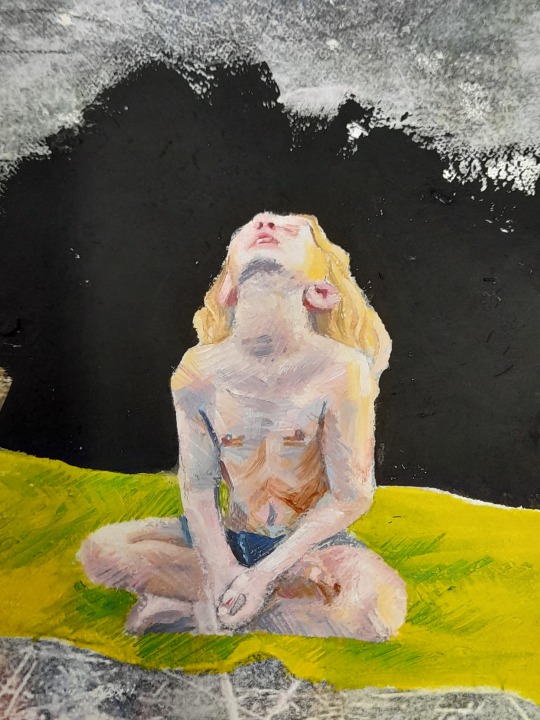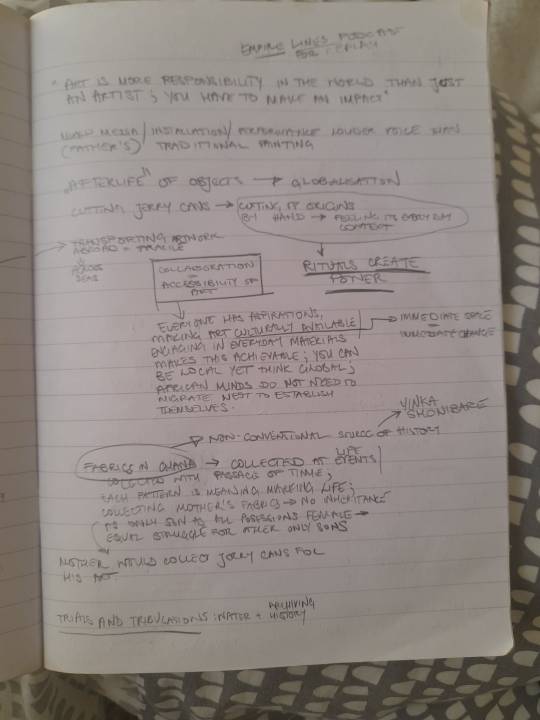Text
ART420: Posters for Palestine



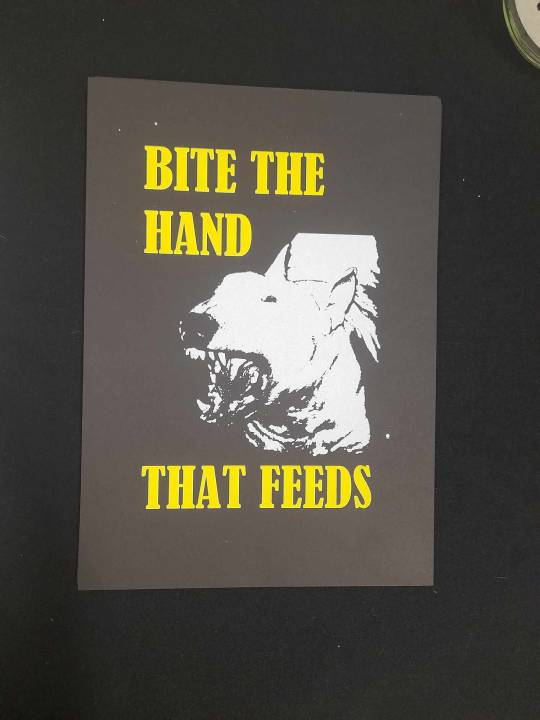
Posters for Palestine, a way of occupying public space within the academic sphere, raising money for Palestine and further developing my artistic and curatorial practice.
I knew for sure I wanted to create a pop-up stall with which visitors can interact, donate etc. without my presence there. I also was certain I didn't wish to humble its cause. My initial idea was to cover the wall with collage, however this proved impractical due to a lack of relevant newspaper coverage on the crisis. I wanted to use only newspapers to maintain the reality of the events being brought to light - this isn't a chosen interest, it is happening this moment and where you all see it, on the news, in the papers. Unfortunately, genocide has proved not to be a front-page story and I had to adapt the layout to a small collaged banner.
The rest of the installation was a simple case of delivering the information I wished to get across in the most efficient, non-inflammatory way.
The prints themselves as mentioned in the statement for this piece, hold no related political value. They are more reflective of my artistic practice, motifs and subject matter I am drawn to. The purpose of this stall was to raise money: for this reason the content is palatable and not confrontational.
0 notes
Text
Finalizing
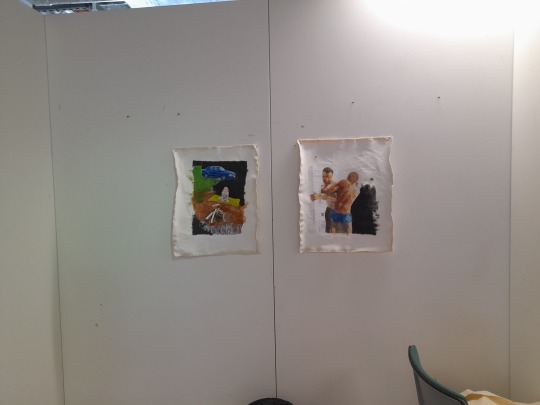
I have decided to keep the edges rugged/leave the canvases unframed. The lighting is a bit off balance. I was discussing with Kurtis Lesick to try hangng them off the wall.

Next steps: split the plaster brick in half, batter the car wing. Find wooden beam to hang paintings.
0 notes
Text


Fuck it, concrete block.
The first section (top) was mixed before pouring and is smoother than the bottom half, which was done as said on the packet, pouring the concrete mixture and then watering it until bound. In total this required around 60kg concrete, and 15kg water by estimate). I have also made several small plaster sculptures to go with it, including a small (15x25) brick
0 notes
Text
I started a second painting because I got tired of the same one every day.
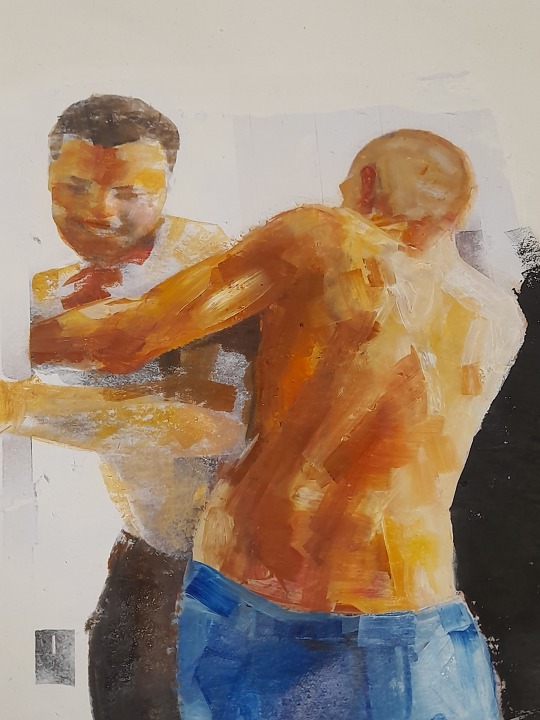
I want the two to interact in contrasting ways. One is a very serene and mindful scene, capturing sensory memories of childhood. This one has teeth and is rougher round the edges.
Ironically it is just a well-captured scene from Easter Monday celebrations Śmigus Dyngus but that kills the narrative a bit.
0 notes
Text
Developing Practice

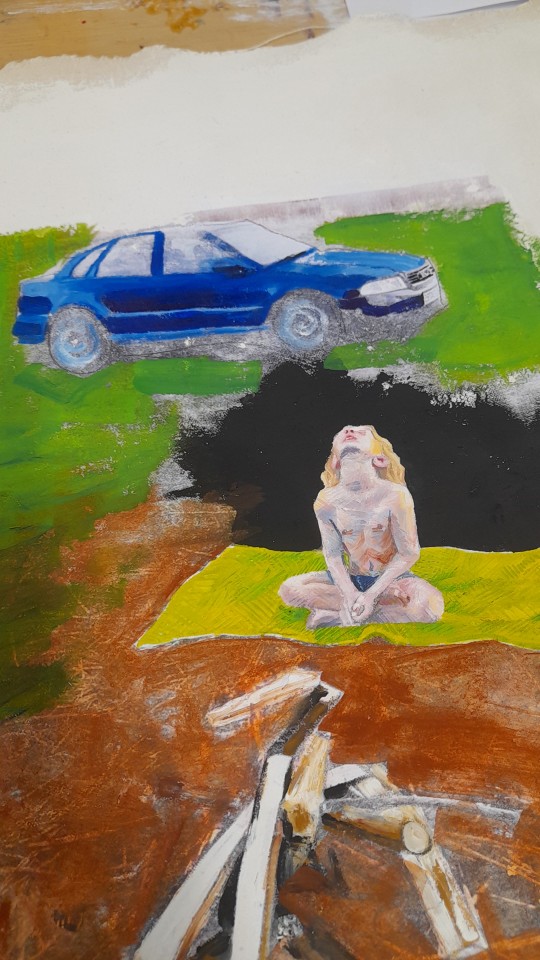
The red sun was the resignation point.
I began the second painting with an emulsion transfer instead of a sketch, as I did not have the time nor patience. I had several photos that had a poetic sensitivity to them but this one was particularly appealing. It was composed like a sensory memory.
The emulsion transfer was not only for convenience, but added texture and information to the canvas. I was not starting on blank again. The process of wetting the image, peeling back the paper, drying and repeating was also a much needed change of pace.
0 notes
Text

A la Martin Brooks workshop? Intuitive mark making?
My initial idea was to build on Lack of Capacity using marks that imitated bruises during my withdrawal and recovery. I do not have any ideas, I cannot come up with anything that isn't a direct continuation of semester 1 but I am sick to shit of it. I could not paint the bruising on the big painting I don't think I will now.
0 notes
Text
Group Tutorials
I did not participate in the group tutorials and I was out of the country for the duration of the Creative Futures Day.
0 notes
Text
Interdisciplinary Project Proposal
Following the lecture on Activism, I can see a very clear correlation between my practice and the themes discussed - particularly with the crisis in Palestine which has been a focal point in my extracurricular activities. There have been brief encounters with current events during the workshops, for example the curatorial workshop with Mike in Semester 1, however considering the extent of the conflict, the narrative of false neutrality that educational institutions wish to uphold is something that must be confronted more directly.
I have been engaged with Solidarity groups since the beginnings of the war, attended both student-led and politically-aligned events pushing awareness and action, and urging for ceasefire, including and demonstration in London in November. Considering activism is already a prominent part of my life, it feels natural to align it with my artistic practice and more importantly bring the discussion into educational spheres of influence.
I have already had ideas of printmaking and fundraising during my screenprinting induction. I feel the natural course of action would be to continue in this direction throughout the semester, developing new designs and raising funds for causes like MAP (Medical Aid for Palestinians).
In the lecture, Judith Butler's theatre of legitimacy was discussed and the way the status quo is upheld in a public sphere. The theatre of the lecture halls urges non-involvement, detatchment from associations that will cost them in profit. The severance of this theatre of legitimacy is occupying the public space - physically and in discussion.
0 notes
Text
Activism
Activism
Judith Butler: Bodies in Alliance and Politics of the Street in Sensible Politics
Butler explores the relation of the body its representation in relation to order – otherwise called „theatre of legitimacy”. The way actions, status and context of the two in relation to place can have revolutionary effects or the opposite, and how in more modern context the media is placed into this equation. Butler also disputes the idea that the eye of the media is not a viable form of „body”/that media presence does not demonstrate in the same way physical occupation demonstrates (establishes itself in a public space). This is, however, disputable since 2012 when Butler made this argument as more commonly brief media show of solidarity has largely replaced physical occupation of space. In this way despite its larger numbers it more easily governable than a breathing crowd, through censhorship, algorithms (as Butler has made evident the fact that „the dominant media are corporately owned” and thus benefit from their role in the theatre of legitimacy.)
•Theatre of Legitimacy: theatre/appearance of a regime „is no longer unproblematically housed in public space, since public space now occurs in the midst of another action, one that displaces the power that claims legitimacy precisely by taking over the field of its effects.”
•„just as they sometimes fill or take over a public space, the material history of those structures also works on them, becoming part of their very action” à actions placed in context, targeting sites of political wounding or of social significance in order to wound.
•„Such a struggle intervenes the spatial organisation of power, which includes the allocation and restriction of spatial locations in which and by which any population may appear, which implies a spatial regulation of when and how the ‚popular will’ may appear.”
•„Tahrir Square” à 25 January Revolution in Egypt in response to police brutality, state-of-emergency laws, lack of political freedom, corruption, unemployment, inflation etc of the Hosni Mubarak regime. Butler specifically references the occupations of plazas.
•Mubarak regime’s „entrenched hierarchies [...] differentials of wealth between the military and corporate sponsors of the regime and the working people.” à In the resistance „how people cared for their various quaters within the square, the beds on the pavement” etc. The theatre of legitimacy is not only in the politics of the regime but in the values it enforces. Occupying the public space, there is no division like in the home or the workplace, women and men, abled and disabled, people of all backgrounds exist in a new temporary social structure that destabilises the previously enforced, even if just from observing and not partaking. „they were breaking fown a conventional distinction between public and private in order to establish new relations of equality; in this sense they were incorporating into the very social form of resistance the principles they were struggling to realise in broader political forms.”
•Chants of silmiyya „a gentle exhortation: peaceful, peaceful” – „the collective chant was a way of encouraging people to resist the mimetic pull of military aggression.” à a space previously governed by regime, thus incentivised for violence, being reestablished and furthermore pushed towards nonviolence in order to sever theatre of legitimacy. „language worked not to incite inaction, but to restrain one”
•On media revolution Butler poses two initial questions: How does media revolution make actual bodies less central to the political action? How important was the locatedness of bodies in the events that took place?
•„Will the Palestinians have their Tahrir Square?” -> Butler did not mention this without reason: the Palestinian question being a timeless territorial battle with annexation, theft of land and colonisation narrowing the field of resistance. I would write that the relevance has increased but it has always been relevant since the Nakba, the land has been thieved along with places of cultural and political significance (‚Tahrir Squares’ of Palestine). 2021 saw expulsion of whole neighborhoods in Sheikh Jarrah to make room for Israeli settlers. Where is the Tahrir Square in a colonial/settler conflict as opposed to the civil conflict? The rules of the game change when you step into territory that is not ‚yours’ on paper.
•„The street scenes become politically potent only when and if we have a visual and audible version of the scene communicated in live or proximate time, so that the media does not merely report the scene, but is part of the scene and action” – If a tree falls in a forest allegory. -> Aaron Bushnell
•„the freedom of the media to broadcast from these sites is itself an exercise of freedom and so a mode of exercising [...] This is doubtless why both Hosni Mubarak and David Cameron, eight months apart, both argued for the censorship of social media networks. At least in some instances, the media not only report on social and political movements that are laying claim to freedom and justice in various ways; the media also are exxercising one of those freedoms” „[...] that Twitter and other virtual technologies have led to disembodiment of the public sphere, I disagree. [...] But under conditions when those with cameras or Internet capacities are imprisoned or tortured or deported, the use of the technology effectively implicates the body.”
•Rob Nixon’s ‚slow violence’: a measure of violence that is not summarised by a casualty count or immediate damage but by the chemical and structural violence committed à e.g. long term effects of white phosphorous bombs on Gaza poisoning the sea, environmental effects of war. Slow violence also focuses on „narrative ways in which to make this slow violence visible and accountable.”
• „what lies beyond the first-hand sensory, or even the time-span of human perception” à Effects of nuclear warfare on Hiroshima/Nagasaki, Vietnam
0 notes
Text
Screenprinting
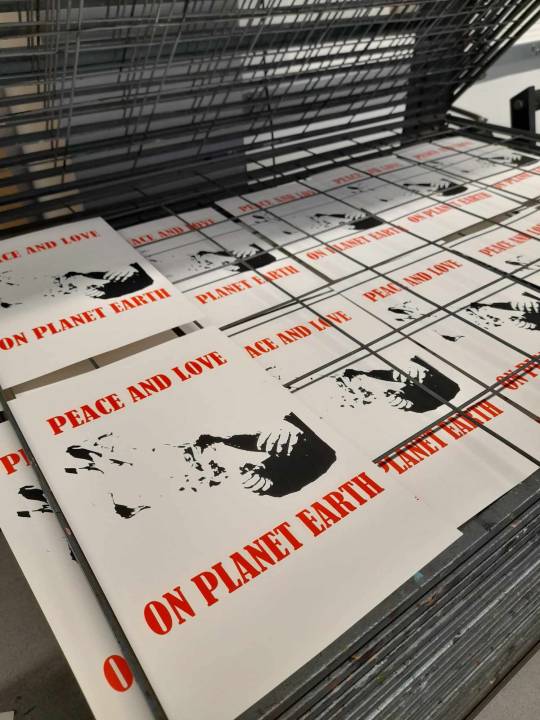
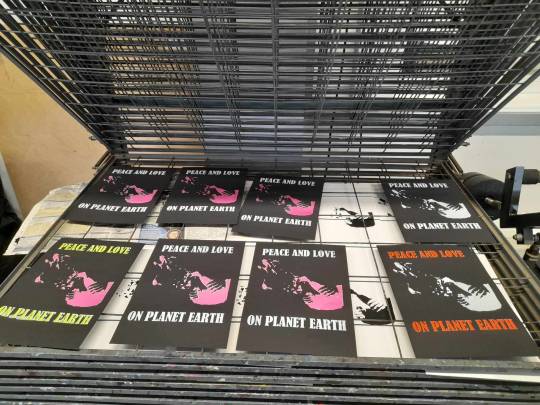
PEACE AND LOVE ON PLANET EARTH
I very much enjoy the rituals of the screenprinting process. You are functioning as all of the cogs in the machine. I chose a stupid and easily adaptable design, first as a print, maybe then I will try printing on textile, making back patches.
I experimented with printing on black which despite some apprehension turned out very vibrant. I am considering making various designs and selling these. Perhaps combining it with one of the interdisciplinary approaches.
0 notes
Text
Body, Land, Object
Body
Understanding the body as a physical medium for art, through the use of 16mm film. The body of art, like the human body, is something that is worked into to create and change its narrative. As the body is altered so is the mind. In this excercise we were given a segment of the 16mm film to play with. With every change made to the segment of film the value of it changed: whether scribbling, blocking out or adding to the scene, the intention scraped into the body of the film changed the information it would deliver.
This workshop questioned how closely body and mind are interlinked. To my understanding, the body and mind are linked more closely than appears - not in a metaphysical or allegorical sense but physically linked through the hormones and senses.
The brain is an organ and a massive database of information which can be triggered through the senses to produce certain reactions. Not only does the human body have five sensory organs constantly in communication with the brain, but the largest - the skin - creates a receptive shell, meaning that the brain is constantly receiving information. This information is processed in the center of memory where the response of the body is chosen from various vivid and less vivid memories that have been programmed into behaviour. Triggering these very specific memories the brain reacts accordingly, releasing a series of hormones affecting bodily performance creating not only emotion and thought but potentially also stronger psychological responses. In particular, the nose, unlike other sensory organs, has a direct route to the thalamus and hippocampus, triggering memories more vivid than for example taste which first makes its way back retronasally before it is processed by the brain.
Land
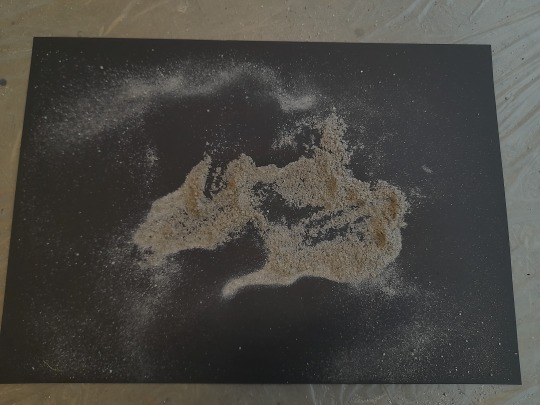
VR and sculptural artist Molly McCarthy hosted a workshop exploring Land as an abstract form. The medium of VR already establishes a separate dimension to what is considered 'land' traditionally - focusing on land as an environment without set physical attributes.
In this excercise we explored land more abstractly - through its material values. Presented with a handful of sand, along with driftwood, stones and other found objects at our disposal, we created sigils.
I used vibration to maintain an organic shape of the sand, maneouvering the grains by tapping onto the floor with various objects at various intensities. The land was moving on its own, my actions were just an enabling factor. It was a hypnotic process, similar to the first few ascemic workshops with Martin Brooks.
Object
For this excercise, I, as the object, lay on the floor.
0 notes
Text
Magic and Chance + Theatre and the Real
•Hilma af Klint – through process becoming an oceanic state (Freudian?)
•Marina Abramović – The offering of labour. „[...] making little Buddhas by repeatedly filling a mould with clay. You make thousands of little Buddha images by putting in eight hours of labour per day. You make a thousand or a million. Then the next three months labour of this sort is done in running water and you don’t see any result because it is invisible. [...] The result is not important. It is the process that matters. It’s about the physical preparation, the labour and the merit that lets us get close to the portal and open it.” à „The Artist is Present” changing lifestyle in advance of performance, adapting eating/sleeping/toilet patterns to fit ritualistic wymagania. The conditioning of body and mind through process.
•What is meant by portal? What is the portal in a less illusionary sense?
•Ana Mendieta’s Siluetas – documenting presencce via absence.
•Themes of the indigenous through Mendieta’s work à Robin Wall Kimmerer on indiginaety through reciprocity; the idea that a person may over time and labour become indigenous to a place or land through the care they contribute both physically and in community: „It was through her actions of reciprocity, the give-and-take with the land, that the original immigrant became indigenous. [...] to take care of the land as if our lives, both material and spiritual depended on it.”
•Kimmerer’s Braiding Sweetgrass:
•Ana Mendieta murdered by her partner Carl Andre 1985
•David Abrams on magic: „[senses] are very gregarious organs that participate spontaneously in the things they perceive. [...] Perhaps due to our language, articulating the world as a set of objects, mechanical processes...
•There are other ways of knowing than the ones put forward by rationality. We as humans are out of tune with this knowledge and the reception of this knowledge due to being fixated on our concepts of things as opposed to the things themselves. (Glass wall)
•Being taken out of your normal understanding heightens sensorial consciousness.
Isabelle Stengers on capitalist sorcery
If there are two words that do not belong next two each other it is capitalism and sorcery. I understand through the previous texts the concepts of magic as a churning energy in both body and mind. It is throughout the texts an awakening force. Therefore I cannot read Stengers’ writing without feeling it is deprived of sensibility. Capitalism is not an awakening force, ethereal and unstoppable, but meticulous and entirely technical manipulation of the mass subconscious into submission that can only result in burnout. It is the antithetic portal to that which Marina Abramović sought to reach – if it can be called a portal at all. It is sooner a disease of the brain or a cancer than it is a sorcery.
THEATRE AND THE REAL
TASK: Film Stills
Ref. to The Belief in Things Disappearing (Mirror PCA gallery 28/11/23) Jo Lathwood. Video piece with magician linking waste disposal and themes of magic, runes etc. „Traditionally magic held a space between art and science that used to be a much bigger part of our understanding of the world. Magic resides in the realm of the unknown and as technology has advanced there is less space for grey areas, deception or pure belief. We watch as items vanish in the magician’s sleight of hand trick, knowing it for what it is.” Links to waste collection and disconnect from our active consumerism. Lathwood’s video piece Alchemical Symbols. „We can create or destroy objects but the resources on the earth are finite.”
Anyway, the following film stills were our disruption of reality:


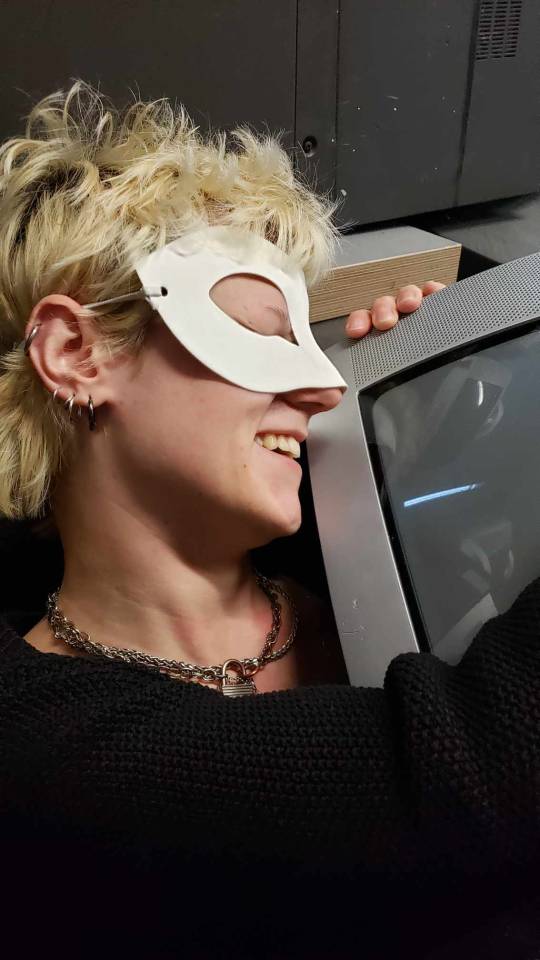
0 notes
Text
Land and Deep-Mapping
Trespass
•„The act of trespass – the wilful intrustion of a person upon the land in possession of another – is rooted in the history of enclosure in England”
•„Berger interprets [Gainsborough’s painting of Mr and Mrs Andrews] as a celebration of property.” à compositionally the Andrews’ thoughb at the forefront of the image take up one one third of the space. The remaining two thirds exhibits a vast controlled landscape, hectares of fields all enclosed and tended. The Andrews’ only purpose in the painting is to overlook these fields – to give them ownership. There is nothing serene about the painting.
•The system of enclosure was a prototype for colonial expansion.
•„In the age of Brexit and its aftermath, issueas around land ownership and the thresholds between public and private land, and how these relate to national identity and belonging, remain urgent” à Right to Roam and privatisation attempts on Dartmorr, Kill The Bill movement that started as a compromisation of traveller’s rights (?) and then rights to protest (Land as government property?)
The Natural – Carl Zimmer, The Awe of Natural History Collections, Seed Magazine 2009
•Concepts of museums, natural objects as possessions, wunderkammers.
•„Renaissance monarchs housed personal collections of exotic oddities, like buzarre deep-sea fish, glittering crystals, exquisitely geometrical shells. Kings and queens would retire to these cabinets to contemplate nature, or just use them to dazzle their visitors.” à exoticism as knowledge, wealth.
•„Gradually, royalty’s cabinets of wonders turned into libraries of flesh and rock, where scholars could research the workings of the world.” à biology intrinsically related to art – sketches, etchings, diagrams of the contents of the wundercammers. In order to have the most accurate research you needed a good hand to record it visually.
•„... Museum collections grow into their own cumbersome beasts that require much care and feeding.”
•„Museum collections also uniquely capture nature’s variety accross space – a tray of butterflies can reveal the flow of genes across a river basin, the rise of new mutations, and the effects of genetic drift and natural selection – as well as time.” à The natural is a visual phenomenon.
•„The scientists discovered that mammals have moved up the slopes due to climate change. They are an ominous reminder that the collections that Cooper so lovingly portrays are not just a repository of the past, but a stake in out future.”
Vibrant Matter – Jane Bennet
Exploring the philosophy of the natural world as divided into two parts: dull matter (it, things) and vibrant matter (us, beings).
DEEP-MAPPING
Task: Deep-mapping
For this excercise I developed a cartographic rendition of a space where many key events in my adolescence took place, using happiness and stress hormones to develop a sense of place and time. As with cartographic maps, the areas with denser activity serve as peaks of psychological activity. The blue line marks the release of cortisol and adrenaline, while the pink line marks oxytocin and dopamine. In the midst of these lines are printed sensory details associated with these peaks and troughs.
0 notes
Text
Health and Bookbinding
Illness as Metaphor, Susan Sontag (1978)
In paradox to the title, Sontag’s text opens with metaphor, exloring the theme of health as a dual citizenship passport which is used alternately throughout ones lifetime. This imagery proves only the more compelling as Sontag makes her argument on the approach and reception of illness, particularly cancer in her contemporary culture.
•„...the healthiest way of being ill – is one most purified of, most resistant to, metaphoric thinking.”
•„illness experienced as a ruthless secret invasion”
„a disease regarded as a mysterious malevolency”
„as long as a particular disease is treated as an evil, invincible predator, not just a disease...”
•„In France and Italy it is still the rule for doctors to communicate a cancer diagnosis to the patient’s family but not to the patient; doctors consider that the truth will be intolerable to all but exceptionally mature and intelligent patients.”
•„Cancer patients are lied to [because the disease] is felt to be obscene [...] Cardiac disease implies a weakness, a trouble, failure that is mechanical; there is no disgrace, nothing of the taboo...”
Epilogue – Audre Lorde (1988)
Like Sontag, Lorde reflects on cancer through personal experience, though her account is proves more direct, approached more personally from the queer black perspective.
•„Caring for myself is not self-indulgence, it is self-preservation, and that is an act of political warfare.” à It is argued Lorde coined the first ideas of ‚self-care’ and as evidenced through this essay it is far from the modern capitalist ideas of pampering oneself through consumerist rituals. As she goes on to say in the following paragraphs, caring for oneself has many institutional obstacles – black patients are statistically neglected by doctors or more prone to medical malpractice.
•„Building a strong and elegant pathway toward transition.” à Death is portrayed actively by Lorde, as a process of life, not as an end or a slumber or imminent doom. It is not met with warmongering rhetoric e.g. Losing a battle.
Mark Quinn’s statue of Alison Lapper pregnant.
What was Alison Lapper’s involvement and what moral discourses arise from the project?
Sick Woman Theory – Johanna Hedva (2016)
Johanna Hedva’s Sick Woman Theory, though arguably encompassing a very diverse set of experiences of illness, is a very American manifesto – individualistic, full of buzz words, expanding on sections relevant to oneself and neglecting those that do not cater to her establishment of her own identity as the Sick Woman.
•„The Sick Woman is a straight man with depression who’s been medicated (managed) since early adolescence and now struggles to work the 60 hours per week that his job demands.” à ref. Narcocapitalism by Laurent de Sutter
•„The Sick Woman is the refugee/abused child/starving.”
•„When being sick is an abhorrence of the norm, it allows us to conceive of care and support in the same way”
•„To take seriously each other’s vulnerability and fragility and precarity, and to support it, honor it, empower it. To protect each other, to enact and practise community.” à Though it has not been proven, it is said anthropoligist Margaret Mead stated one of the first signs of civilisation was a broken and then healed femur.
BOOKBINDING
TASK: The Passport


The passport above resides in my sketchbook. The passport is divided into sections of colour and monotony, in which colour defines health and monotony decay. Throughout life the two are in conversation with one another - with the exception of a few childhood moments at the beginning of the passport.
Here is the thought process numbered by page:
1. The Republic of Life
2. "First you are a child" ejected from a pair of legs.
3. The development at this early stage is pivotal to cognitive balance. The sea cuts off the development of 'home'.
4. As the Placebo song once said:
4723985 - I gotta breathe to stay alive;
and 142978 - feels like I'm gonna suffocate
At this point in life you will encounter gay sex.
5. The joys of teenage mischief.
6. The woes of teenage mischief.
7 - 10. The fateful events of September 20th 2020 that you will be tired of seeing used as motifs.
11. Remapping cognitive function
12. Colour is restored, but not to the hands
13. Colour is restored, you are still being watched
14. Colour is restored, for better or for worse
15. The Death page.
0 notes
Text
Sexuality and Autoethnography
Laura Mulvey’s theory of the ‚male gaze’
•Socophilia and the sensual experience of observing films à Oscars debate between Romeo and Juliet and Saving Private Ryan on film exhibition effects on viewing film etc. (unrelated to sexuality)
•„[...] film is a reflection of the dynamics at work in everyday life”
•„Traditionally, the woman displayed has functioned on two levels; as erotic object fro the characters within the screen story, and as erotic object for the spectator within the auditorium, witha shifting tension between the looks on either side of the screen” à therefore predatory from either side making the female subject an object of consumption from all perspectives. There is no agency. These expectations have thus shaped cinematic technique and developed gendered shooting habits among filmmakers.
•„Its danger lies in its correspondence to the societal positioning and treatment of women. [...] women are a canvas on which male desires are projected, hence subverting female agency and power” à woman „as a bearer of meaning, not maker of meaning”!!
While I understand the importance of exploring the themes of the male gaze and its relation to sexuality in the visual arts it becomes repetitive after the first few encounters. Mulvey makes an excellent argument, the examples are as frequent as price tags in a supermarket. There was very little being explored of sexuality outside of the Mulvey-centric perspective and outside of sexuality as a masculine assertion of power. Relations between gender and sexuality, sexuality as a behaviour, hormones and desire and psychology, make up as much of the scope of the word as gender politics. I am bored of scratching the surface of the subject of sexuality. I have worked with queerness, gay and trans sexuality, injured or repressed or somewhat broken, since the feelings first started churning between my ribs. Queerness to sexuality is a liberation – the blatant disregard, disrespect and anarchy of the gender norm creates purity, freedom and joyous expression.
AUTOETHNOGRAPHY
There was a task, I didn't take part actively, I coloured a page all in black.
0 notes
